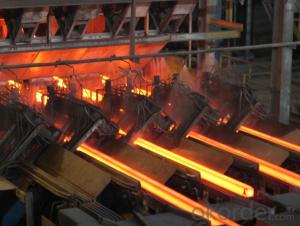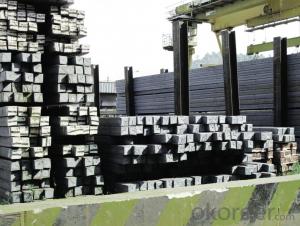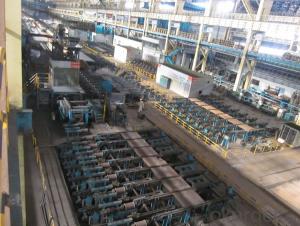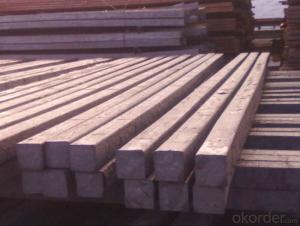Q235/3SP 90MM Blast Furnace Hot Rolled Steel Billet
- Loading Port:
- Tianjin
- Payment Terms:
- TT OR LC
- Min Order Qty:
- 2000 m.t.
- Supply Capability:
- 30000 m.t./month
OKorder Service Pledge
OKorder Financial Service
You Might Also Like
Description of Q235/3SP 90MM Blast Furnace Hot Rolled Steel Billet
Our hot dip galvanised steels consist of a steel substrate with a metallic zinc coating applied by means of a continuous hot dip galvanising process. Metallic zinc coatings are available in steel grades ranging from steel for bending and deep drawing applications, to structural steels and high yield strength steels.
A glossy surface finish obtained under specific skin-pass conditions (either non-skin-passed or skin- passed with smooth cylinders to obtain low roughness) can be provided if required at time of enquiry.
Advantage of Q235/3SP 90MM Blast Furnace Hot Rolled Steel Billet
Uncoated CR steel sheet With the features of in line with the international highest standards in demension and shape, excellent surface finish and properties, the products are mainly used in home appliance and automobile industries.
Galvanized steel sheet(include HDG and EG)
With the features of good corrosion resistance, the products are mainly used in automobile, home appliance, electronics, building and machinery manufacture industries, etc.
Precoated steel sheet With the features of enviromental protection and good processablility, long lasting surface durability, rich in colors, the products are maily used in building, home appliance and furniture industries, etc.
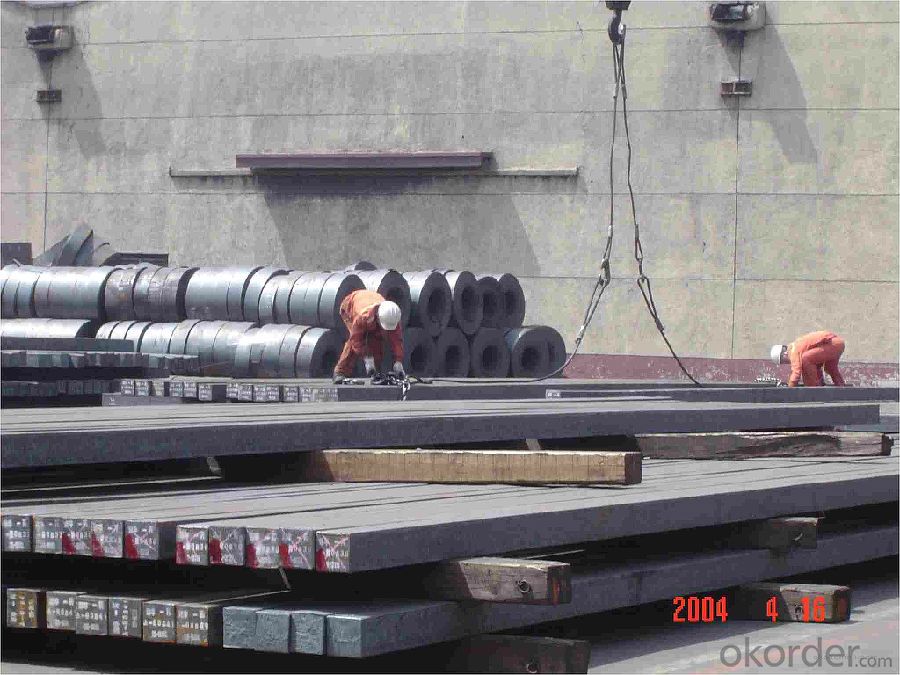
Applications of Q235/3SP 90MM Blast Furnace Hot Rolled Steel Billet
Our hot dip galvanised steels can be used in a very wide range of applications for industrial markets, both indoors and outdoors. Some of the most common applications are:
Building: wide sections for roofing and cladding, doors, door frames, metallic ceilings, partitions, structural members etc
Domestic appliances: all appliances for this sector (both white and brown goods) are manufactured with hot dip galvanised steels
Miscellaneous: electrical cabinets, aeraulic components, air conditioners, road signs etc
Zinc hot dip galvanised steel is suitable for contact with foodstuffs under certain conditions, as specified in European directive 89/109/EEC and French standard NF A 36-712-1. Please contact us for further information on this subject.
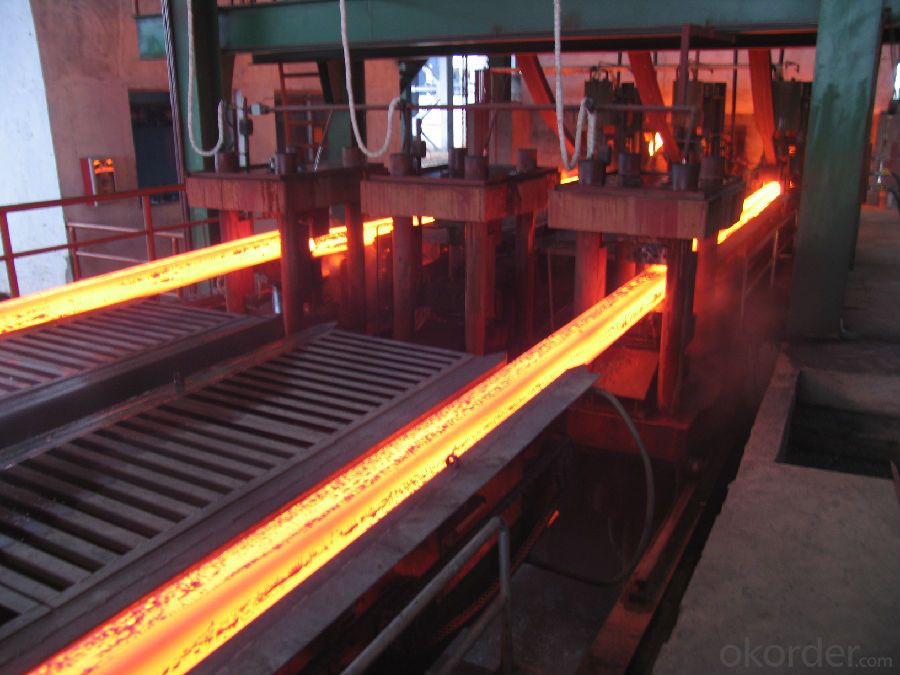
Specifications of Q235/3SP 90MM Blast Furnace Hot Rolled Steel Billet
Quality | Q/BQB 440-2003 | JIS G3312-1994 JIS G3321 | EN 10326-2004 | ASTM A653-02a |
EN 10327-2004 | (BASE PLATE) | |||
(BASE PLATE) | ||||
Commercial Steel | DC51D | SGCC SGLCC | DX51D+Z DX51D+AZ | CS Type A/B/C |
Forming Steel | St01,St02,St03 | SGCD1 SGLCD1 | FS Type A, Type B | |
Drawing | DC52D /DC53D | - | DX52D+Z DX52D+AZ | DDS TYPE A/C |
Steel | DX53D+Z DX53D+AZ | |||
Structural | S280GD (StE28) | SGC400 SGLC400 | S280D+Z DX54D+AZ | SS275 |
Steel | S350GD (StE34) | SGC440 SGLC440 | S350D+Z S350D+AZ | SS340 Class1 |
FAQ of Q235/3SP 90MM Blast Furnace Hot Rolled Steel Billet
We have organized several common questions for our clients,may help you sincerely:
1. How Can I Visit There?
Our company is located in Tianjin City, China, near Beijing. You can fly to Tianjin Airport Directly. All our clients, from home or aboard, are warmly welcome to visit us!
2. How Can I Get Some Sample?
We are honored to offer you sample.
3. Why choose CNBM?
Our delivery time about 15-20days for standard sizes, if you have other requirements like hardness, quanity and width ,it is about 20-40days. But don't worry we also try our best for the delivery time ,because time longer and our cost is higher.
- Q:What are the main factors affecting the thermal conductivity of steel billets?
- The thermal conductivity of steel billets is influenced primarily by several factors. Firstly, the chemical composition of the steel plays a crucial role in determining its thermal conductivity. Elements like carbon, manganese, and silicon can impact the crystal structure and atom arrangement within the steel, thereby affecting its ability to conduct heat. Generally, steels with higher carbon content have lower thermal conductivity due to increased impurities and non-conductive carbide formation. Secondly, the microstructure of the steel also affects its thermal conductivity. Heat conduction in steel happens through lattice vibrations called phonons. Grain boundaries, dislocations, and other defects within the microstructure can hinder phonon movement, resulting in reduced thermal conductivity. Conversely, a more uniform and fine-grained microstructure enhances thermal conductivity. Furthermore, the temperature of the steel billet significantly impacts its thermal conductivity. As the temperature rises, the thermal conductivity of steel generally decreases due to increased scattering of phonons by lattice vibrations and higher thermal resistance. Another factor influencing the thermal conductivity of steel billets is their physical dimensions, specifically cross-sectional area and length. A larger cross-sectional area leads to higher thermal conductivity as there is more space for heat transfer. Similarly, longer billets tend to have lower thermal conductivity due to increased distance for heat conduction. Lastly, the presence of impurities and alloying elements in the steel can also affect its thermal conductivity. For instance, alloying elements like nickel, chromium, and copper can alter the crystal structure and lattice vibrations, thereby influencing the thermal conductivity of the steel billet. In conclusion, the thermal conductivity of steel billets is influenced by factors such as chemical composition, microstructure, temperature, physical dimensions, and the presence of impurities and alloying elements. Understanding these factors is crucial in various industrial applications where heat transfer and thermal management are critical.
- Q:What are the potential applications of steel billets in the food and beverage aftermarket?
- Steel billets have limited applications in the food and beverage aftermarket due to their inherent properties and composition. However, they can be used in certain non-direct contact applications such as equipment fabrication, machinery parts, or structural components in food processing facilities. These billets can provide strength, durability, and stability, contributing to the overall infrastructure and functionality of the food and beverage industry.
- Q:Can steel billets be customized according to specific requirements?
- Certainly, specific requirements can be taken into account when customizing steel billets. Steel billets, which are semi-finished products typically used for further processing in the production of various steel products like bars, rods, and wire, can be tailored to meet different applications by adjusting their dimensions, chemical composition, and mechanical properties. When it comes to customization, steel billets can be modified in terms of their size and shape. To ensure optimal efficiency during subsequent processing, the length, width, and thickness of the billets can be altered depending on the requirements. Furthermore, the shape of the billets can be customized to match the desired end product, be it square, round, or rectangular. Moreover, the chemical composition of steel billets can be adjusted to achieve specific properties. By altering the percentage of elements like carbon, manganese, and alloying elements such as chromium or nickel, the steel can be tailored to exhibit certain characteristics, including increased strength, improved corrosion resistance, or enhanced weldability. Lastly, the mechanical properties of steel billets can be customized through heat treatment processes. Techniques like quenching and tempering can be applied to control the hardness, toughness, and overall strength of the steel, making it suitable for specific applications. In conclusion, steel billets can be customized in terms of size, shape, chemical composition, and mechanical properties to meet specific requirements. This ensures their effective utilization across various industries and applications.
- Q:How do steel billet prices fluctuate in the market?
- Steel billet prices fluctuate in the market due to a variety of factors. One of the key factors is the demand and supply dynamics of the steel industry. When there is high demand for steel billets, prices tend to rise as suppliers have more leverage to set higher prices. Conversely, when demand is low, prices may decrease as suppliers compete for a smaller pool of buyers. Another important factor influencing steel billet prices is the cost of raw materials. Steel is primarily made from iron ore, coal, and scrap metal, and any fluctuations in the prices of these raw materials can directly impact the cost of producing steel billets. For example, if there is a shortage of iron ore, the price of steel billets may increase due to higher production costs. Additionally, market conditions and economic factors can also affect steel billet prices. Factors such as inflation, interest rates, and currency exchange rates can impact the overall cost of production and transportation, which in turn may influence the prices of steel billets. Furthermore, geopolitical events and trade policies can also play a role in price fluctuations. Tariffs, trade disputes, or changes in import/export regulations can disrupt the supply chain and impact the prices of steel billets. Overall, steel billet prices are subject to a complex interplay of factors, including demand and supply dynamics, raw material costs, market conditions, and geopolitical events. Traders, manufacturers, and investors closely monitor these factors to anticipate and respond to price fluctuations in the steel billet market.
- Q:Can steel billets be painted or coated for decorative purposes?
- Yes, steel billets can be painted or coated for decorative purposes. The surface of steel billets can be prepared and treated to ensure proper adhesion of paint or coating, allowing for customization and enhancing their appearance for decorative applications.
- Q:How are steel billets cut into desired lengths?
- Various cutting techniques are commonly used to cut steel billets into desired lengths. One of the most frequently employed methods is saw cutting, where a high-speed circular saw with a carbide or diamond-tipped blade is utilized. By securing the billet in place, the saw blade is brought down to create the required length. Another method is torch cutting, which involves the use of an oxy-fuel torch. This torch produces a high-temperature flame directed onto the billet, causing it to melt and be cut through. Torch cutting is preferred for larger and thicker steel billets, as it allows for greater flexibility in cutting irregular shapes or angles. Moreover, plasma cutting is another technique utilized for cutting steel billets. It employs a plasma torch that generates an electrically conductive plasma arc. This arc melts the steel and blows away the molten metal, resulting in a precise and clean cut. Plasma cutting is particularly beneficial for thicker steel billets or intricate shapes and designs. In summary, the choice of cutting technique for steel billets depends on factors such as size, thickness, precision, accuracy, and specific requirements of the end product.
- Q:Can steel billets be used in the production of marine equipment?
- Yes, steel billets can be used in the production of marine equipment. Steel is known for its strength, durability, and corrosion resistance, making it a suitable material for marine applications. Steel billets, which are semi-finished products in the steel manufacturing process, can be further processed and transformed into various marine equipment components such as ship hulls, propeller shafts, rudders, and offshore structures. The high strength-to-weight ratio of steel makes it ideal for handling the demanding conditions encountered in marine environments, including exposure to saltwater, extreme temperatures, and mechanical stresses. Additionally, steel can be easily fabricated, welded, and machined, allowing for the customization and production of complex marine equipment designs. Overall, steel billets are a valuable raw material in the production of marine equipment due to their strength, durability, and suitability for marine applications.
- Q:What are the different types of steel billet surface treatment defects?
- There are several types of steel billet surface treatment defects that can occur during the manufacturing process. These defects can affect the quality and appearance of the steel billets, and it is important to identify and address them to ensure the overall performance of the final product. 1. Scale: Scale is a common defect that occurs when the steel billet is exposed to high temperatures during the manufacturing process. It appears as a layer of oxide on the surface of the billet, which can affect the adhesion of coatings or paints. 2. Inclusions: Inclusions are non-metallic particles or impurities that can be present on the surface of the steel billet. These inclusions can be caused by various factors, such as inadequate cleaning or improper handling during the manufacturing process. They can negatively impact the mechanical properties of the steel and reduce its overall performance. 3. Decarburization: Decarburization is a defect that occurs when the surface layer of the steel billet loses its carbon content due to exposure to high temperatures or a lack of protective atmosphere. This can lead to reduced hardness and strength in the affected area. 4. Pitting: Pitting is a localized defect that appears as small cavities or pits on the surface of the steel billet. It can be caused by the presence of impurities or by exposure to corrosive environments. Pitting can compromise the structural integrity of the billet and make it more susceptible to corrosion. 5. Surface cracks: Cracks can occur on the surface of the steel billet due to various factors, such as thermal stress, improper handling, or inadequate cooling. Surface cracks can weaken the billet and increase the risk of failure during subsequent processing or use. 6. Surface roughness: Surface roughness refers to an uneven or irregular surface texture on the steel billet. It can be caused by factors such as improper machining, inadequate cleaning, or the presence of scale or inclusions. Surface roughness can affect the appearance of the billet and may also impact its performance in certain applications. Overall, it is crucial to identify and address these surface treatment defects to ensure the quality and reliability of steel billets. Proper manufacturing processes, including adequate cleaning, protective atmospheres, and appropriate handling, can help minimize the occurrence of these defects and ensure the optimal performance of the final product.
- Q:How do steel billets contribute to the overall safety of a structure?
- A structure's overall safety is greatly influenced by steel billets in several ways. To begin with, steel billets act as the raw material for producing steel bars, beams, columns, and other structural components. These components are widely utilized in construction due to their exceptional strength and durability. By utilizing steel billets as the starting material, the resulting steel products display outstanding load-bearing capacity, thereby bolstering the structural integrity of the building. Furthermore, steel billets undergo a rigorous manufacturing process that encompasses various quality control assessments. These assessments ensure that the billets possess consistent and dependable mechanical properties, such as high tensile strength and impact resistance. Consequently, when these billets are employed in constructing a structure, they contribute to its overall safety by providing a dependable and robust framework capable of withstanding external forces like wind, earthquakes, or heavy loads. Additionally, advanced metallurgical techniques, such as controlled cooling or heat treatment, are frequently employed to produce steel billets with specific properties required for structural applications. These processes aid in enhancing the steel's microstructure, reducing internal defects, and improving its resistance to corrosion, fatigue, and other forms of degradation. In turn, this prolongs the structure's lifespan and minimizes the risk of structural failure, ensuring the safety of its occupants. Moreover, steel billets can be manufactured with precise dimensions and tolerances, permitting accurate and efficient construction. This precision in fabrication ensures that structural components fit together seamlessly, reducing the likelihood of gaps, misalignments, or weak points that could compromise the structure's safety. Lastly, steel billets are highly recyclable, making them an environmentally friendly choice for construction. By opting for steel billets, the construction industry can diminish its carbon footprint and contribute to sustainable development. This focus on sustainability aligns with the structure's overall safety, as a sustainable approach guarantees the long-term stability and resilience of the built environment. In conclusion, steel billets enhance the overall safety of a structure by providing construction materials that are strong, durable, and reliable. Their consistent mechanical properties, resistance to external forces, improved microstructure, and precise fabrication ensure a sturdy and secure framework. Additionally, their recyclability promotes sustainability, further enhancing the structure's long-term safety and integrity.
- Q:How do steel billets contribute to the manufacturing of construction products?
- Steel billets are an essential raw material in the manufacturing of construction products. These billets are semi-finished products that are created by casting molten steel into a solid rectangular shape. They serve as the starting point for various construction products, including beams, columns, rods, and rebar. One of the primary ways steel billets contribute to the manufacturing of construction products is through the process of hot rolling. After the billets are cast, they are heated and passed through a series of rolling mills. This process shapes the billets into desired profiles, such as I-beams or H-columns, which are widely used in the construction industry. By providing a consistent and reliable source of raw material, steel billets ensure the availability of structural components necessary for building projects. Steel billets also contribute to the production of reinforcing bars or rebar. Rebar is crucial for reinforcing concrete structures, such as foundations, bridges, and buildings. The billets are heated and then passed through a rolling mill to form long, cylindrical bars with a ribbed surface. These bars are then cut into specific lengths and used to provide tensile strength to concrete structures, enhancing their durability and structural integrity. Furthermore, steel billets are used in the manufacturing of rods and wires that are essential for construction purposes. These rods and wires are commonly utilized in concrete reinforcement, fencing, and suspension systems. By providing a versatile and malleable material, steel billets enable the production of various construction components that are critical for the structural stability and safety of buildings and infrastructure. In summary, steel billets play a crucial role in the manufacturing of construction products. Through processes like hot rolling, they are transformed into various profiles and shapes that are used as structural components in buildings and infrastructure projects. Additionally, steel billets contribute to the production of reinforcing bars, rods, and wires, which provide additional strength and support to concrete structures. Without the availability of steel billets, the construction industry would face challenges in meeting the demand for reliable and durable construction products.
1. Manufacturer Overview |
|
|---|---|
| Location | |
| Year Established | |
| Annual Output Value | |
| Main Markets | |
| Company Certifications | |
2. Manufacturer Certificates |
|
|---|---|
| a) Certification Name | |
| Range | |
| Reference | |
| Validity Period | |
3. Manufacturer Capability |
|
|---|---|
| a)Trade Capacity | |
| Nearest Port | |
| Export Percentage | |
| No.of Employees in Trade Department | |
| Language Spoken: | |
| b)Factory Information | |
| Factory Size: | |
| No. of Production Lines | |
| Contract Manufacturing | |
| Product Price Range | |
Send your message to us
Q235/3SP 90MM Blast Furnace Hot Rolled Steel Billet
- Loading Port:
- Tianjin
- Payment Terms:
- TT OR LC
- Min Order Qty:
- 2000 m.t.
- Supply Capability:
- 30000 m.t./month
OKorder Service Pledge
OKorder Financial Service
Similar products
New products
Hot products
Related keywords

